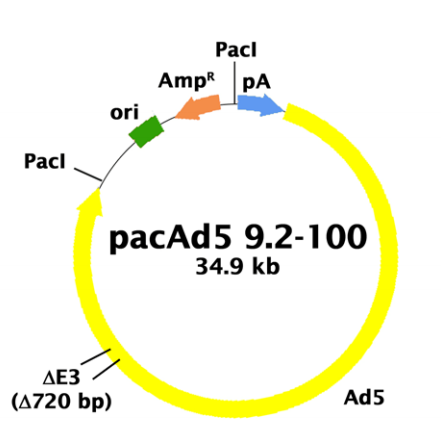×
![]()

- 规格:20μl质粒
- 终止子:SV40 poly(A) signal
- 质粒大小:34947bp
- 原核抗性:氨苄青霉素Amp
- 克隆菌株:大肠杆菌Stbl3
- 质粒简介: pacAd5 9.2-100是一个腺病毒骨架质粒,用于产生腺病毒,pacAd5 9.2-100质粒的参考资料是:RAPAd Universal Adenoviral Expression System(点击查看)
Recombinant adenoviruses have tremendous potential in both research and therapeutic applications.There are numerous advantages they provide when introducing genetic material into host cells. The permissive host cell range is very wide. The virus has been used to infect many mammalian cell types (both replicative and non-replicative) for high expression of the recombinant protein. Recombinant adenoviruses are especially useful for gene transfer and protein expression in cell lines that have low transfection efficiency with liposome. After entering cells, the virus remains epichromosomal (i.e.does not integrate into the host chromosome so does not activate or inactivate host genes). Recently, recombinant adenoviruses have been used to deliver RNAi into cells. Two methods have traditionally been used to generate recombinant adenoviruses. The first involves homologous recombination of a shuttle vector containing gene of interest and an adenoviral backbone plasmid vector (restricted in E1/E3) in an adenovirus packaging cell line. The isolation of recombinant adenovirus by this method involves performing multiple plaque isolations to avoid wild-type virus and is extremely laborious and time consuming. The second method, pAdEasy system, employs the homologous recombination machinery in E. coli, a recombinant adenovirus is produced by a doublerecombination event between cotransformed adenoviral backbone plasmid vector and a shuttle vector carrying the gene of interest. For the pAdEasy method, the system is high fidelity, but inefficient and requires the screening of many bacterial colonies. This results in a significant time commitment even before transfection of recombinant DNA into E1-expressing cells such as HEK293 cells.- 质粒图谱1: png/1-1G1050924134R.png
质粒序列: 点击查看序列